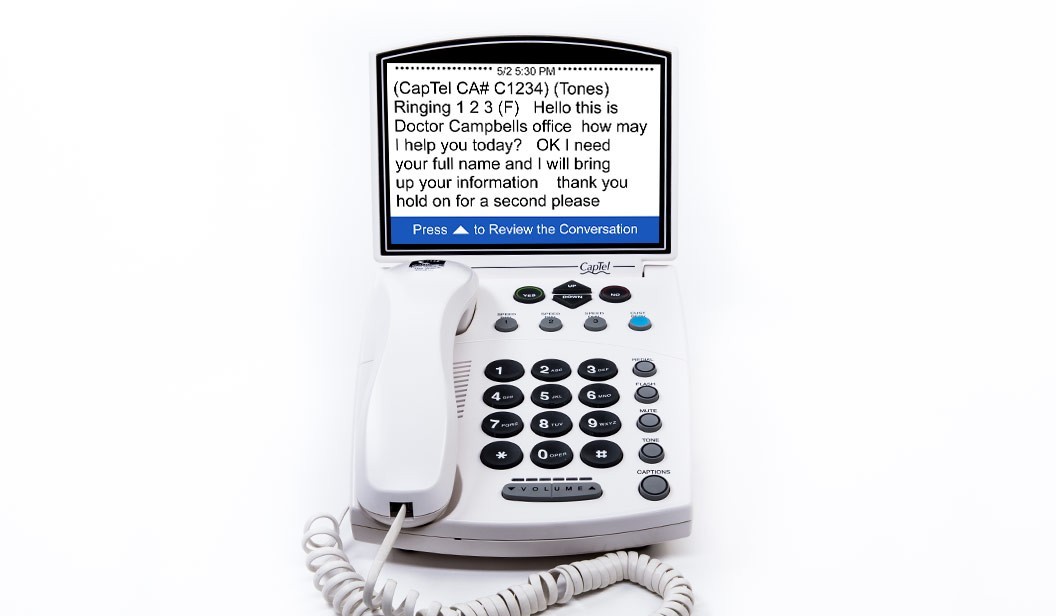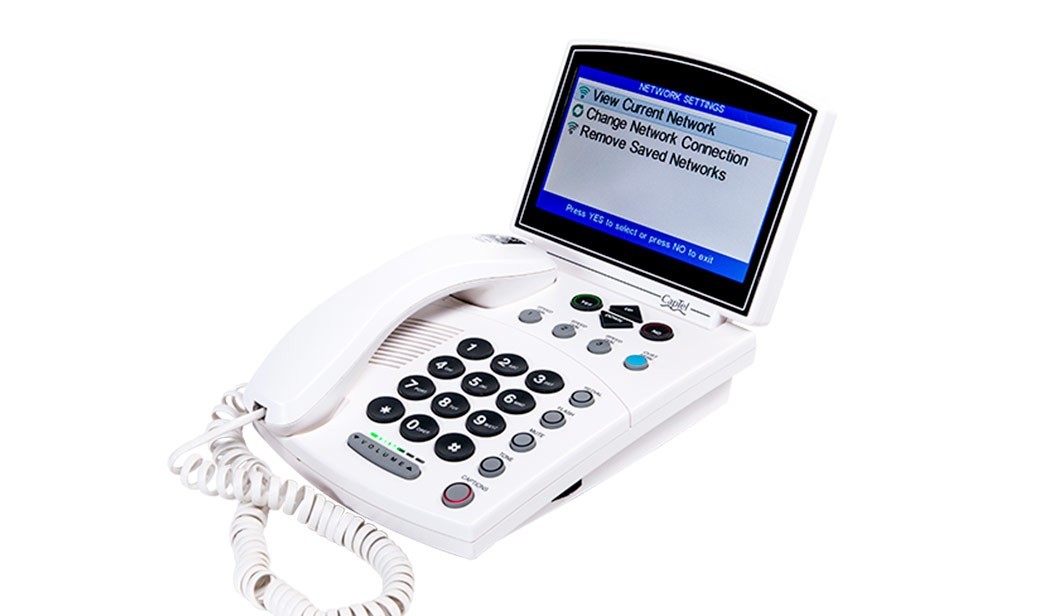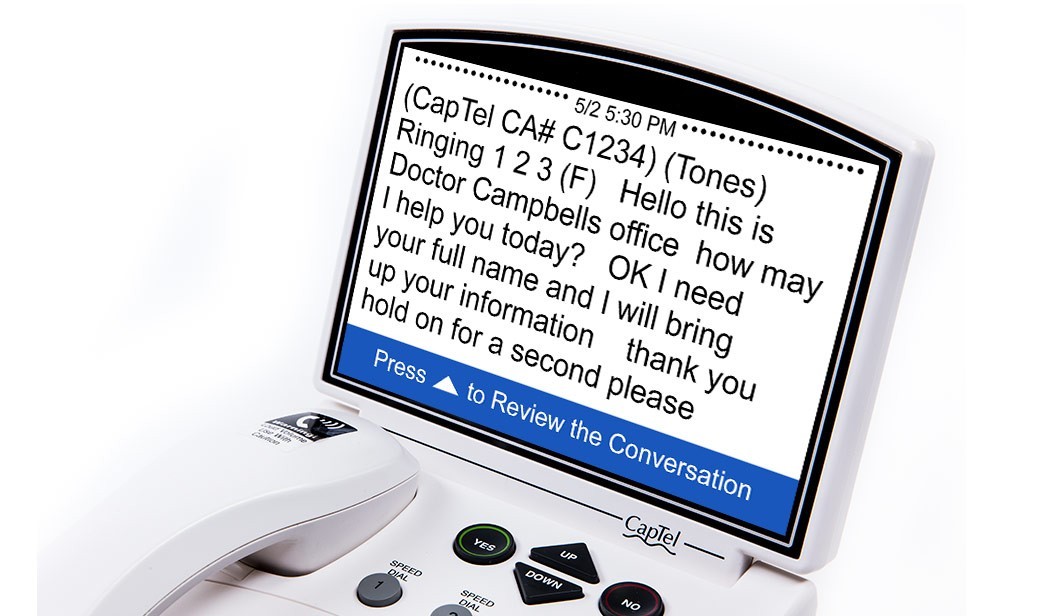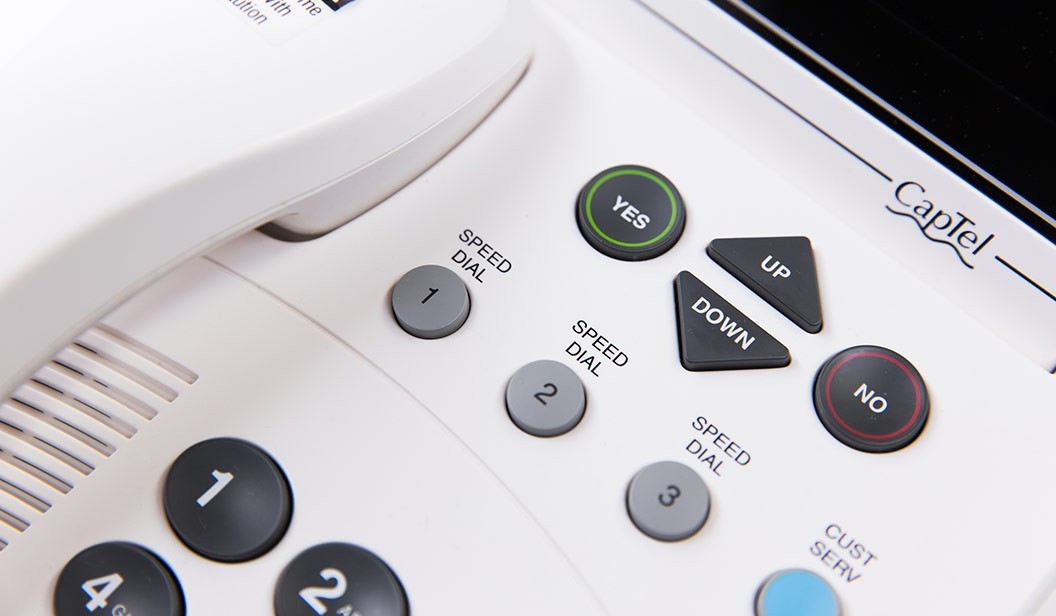



A Basic Phone Line is All You Need
The CapTel 840 captures your conversation by quickly and accurately displaying captions of everything your caller says on a built-in screen. It connects to your standard analog telephone service to give you the best of both worlds - voice and captions. Caption service is free and provided by a call center agent using voice recognition technology.
Features
- Captions must be turned on at the beginning of a call, cannot be turned on/off during a call. (In 2-Line mode only, captions can be turned on/off at any time during a call).
- Incoming callers dial the Call Center first, then enter your phone number, in order for you to get captions. (In 2-Line mode only, callers can dial your phone number directly)
- Adjustable volume control - easy to see and adjust up to 40dB
- Tilt-screen for comfortable reading position or lies flat for wall mount
- Captions appear automatically on both incoming and outgoing calls for 2-Line mode only
- Captions available in English and Spanish
- Captions available only with the U.S.
- Sprint Captioning Service is trusted by the Federal Government
Requirements
- Telephone Service
- Analog telephone line. DSL supported if appropriate filter is in place.
- Not compatible with PBS systems unless an analog port is available.
- Not designed for use with digital cable or VoIP telephone service.
Physical Dimensions
- Size: 9" x 6.5" x 7.5"
- Weight: 2 lb. 10oz.
Power
- AC Adapter: 6 VDC, 2000 mA (barrel is negative)
- Adapter is UL/CSA listed.
Dial Pad
- Large Keys: 0.75" x 0.70"
Display
- Backlit, graphical LCD color display
- 800x480 pixels
Function Buttons
- 3 Programmable Speed Dials
- 1 Customer Service Speed Dial
- Redial
- Flash
- Mute
- Tone
- Captions
- Volume
- Up/Down/Yes/No
Controls
- Conversation: Amplification (0-40 dB gain)
- Tone: Low, Medium, High frequency
- Ringer: Off, Low, Medium, High (0-95 dB)
Indicator Lights
- Mute
- Volume Levels (1 through 12)
- Captions On/Off
Handset
- Type: HAC (Hearing Aid Compatible)
- Style: K-style
Dialing
- Phone Book (97 entries)
- Speed Dial (3 entries)
- Redial (Last 10 dialed numbers)
Connections
- Telephone line: requires RJ11 connection (Does not support digital PBX system unless analog port available).
- 3.5 mm Neckloop/Headset
- 2.5 mm Headset with microphone
- AC power
Conversation Memory
- Approximately 500 lines of text
- 60 answering machine messages (voice & caption)
These files request Adobe PDF reader. Download here.
How does the CapTel 840 function?
There are two main functions:
- CapTel 840 is for people who do not have high-speed Internet access.
- CapTel 840, callers need to dial the captioning service first and enter your phone number in order for you to get captions
* If you use CapTel 840 in 2-Line mode (optional), people can call your number directly, they do not have to dial the service first.
How do I turn caption on/off using the CapTel 840?
 CapTel 840 in 2-line mode, you can turn caption on/off at any time during your call by pressing the CAPTION button. When the red light around the CAPTION button is lit, you will see caption of everything the other party says.
CapTel 840 in 2-line mode, you can turn caption on/off at any time during your call by pressing the CAPTION button. When the red light around the CAPTION button is lit, you will see caption of everything the other party says.
CapTel 840 (in 1-Line mode), you must turn the CAPTION button on before you dial the phone number. You cannot turn caption on during a call. Simply press the CAPTION button (red light around the button is lit) before you dial.
To get captions during an incoming call with the CapTel 840 (in 1-Line mode), your caller must first dial the toll free Captioning Service and enter your phone number in order for you to see captions of the call.
Analog Telephone vs. VoIP
What’s the main difference between analog phone service and Voice over IP service? It’s the way the voice signals are delivered. The analog phone service carries signals over a copper wire while the VoIP service delivers these signals over an IP data network.
Analog phone service
An analog telephone is the traditional landline phone service that is found in many homes and businesses today. Also commonly known as Plain Old Telephone Service (POTS), analog phone service allows subscribers to communicate with one another.
These users are connected through a copper wire subscriber loop which runs from a central switch office to many homes and businesses. Each subscriber is assigned a specific phone number, which allows them to contact one another.
How does it work?
An analog telephone system converts the voice signals into electronic signals. These electrical waves travel over the telephone line until they reach the end destination. Because the analog telephone system offers bidirectional communication, these voice signals can travel in two ways – from one telephone to the other, and vice versa.
VoIP phone service
VoIP, which stands for Voice over Internet Protocol, offers phone service over an IP data network – typically the Internet. While analog telephone subscribers receive a connection from their local phone company, VoIP allows for phone service via an Internet connection from a VoIP service provider.
How does it work?
VoIP services convert analog phone signals into digital signals. These can then be delivered over the Internet, from one home or business to another.
Many businesses use VoIP phone service
Businesses frequently use VoIP because it offers a secure and quality service. They can manage calls over their own private networks. Advanced technology has provided new forms of VoIP. It offers more than communication – users can also host web and video conferences with VoIP.
I don't have two telephone lines - can I still use my CapTel 840 phone?
YES, the CapTel 840 works with just one telephone line as well (1-Line mode). Using 2-Line CapTel is purely optional. You can still make and receive telephone calls with captions with 1-Line CapTel. The main different between 1-Line mode and 2-Line mode is in the way that incoming calls get captioned. With 1-Line mode, callers need to dial the captioning service first, then enter your telephone number, in order for you to see captions of the call. With 2-Line CapTel, you can turn the captions on and off at any time, on any incoming or outgoing call.

